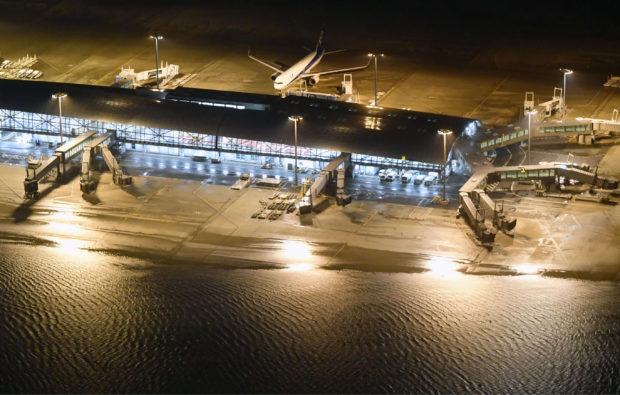Storm-hit Japan airport counts damage; unclear when reopens

Kansai International Airport partially is flooded by typhoon Jebi in Osaka, western Japan, Tuesday, Sept. 4, 2018. A powerful typhoon blew through western Japan on Tuesday, causing heavy rain to flood the region’s main offshore international airport and high winds to blow a tanker into a connecting bridge, disrupting land and air travel. (Nobuki Ito/Kyodo News via AP)
TOKYO — The closure of a major Japanese airport flooded by a typhoon is raising worries about the impact on tourist traffic, mostly from China and Southeast Asia, as well as on exporting computer chips and other goods.
Kansai International Airport officials said Wednesday they weren’t sure when the airport will reopen. Although a damaged runway had been mostly cleared, other equipment to ensure safe flying wasn’t operating.
Visitors are worried and some are rushing to change flights.
About 3,000 passengers stranded at the airport overnight were given blankets and biscuits until they gradually left by boats and buses.
Japan has long had a reputation for transportation that runs like clockwork. But even that couldn’t hold up to the fury of Typhoon Jebi, whose 160-kilometer (100-mile) per-hour winds destroyed buildings, cut off power to more than 400,000 households, and left 11 people dead and 300 injured.
Article continues after this advertisementAdding to the damage was a tanker that slammed into the side of a bridge connecting the airport, built on landfills, to the mainland, further crippling transport. No one was injured in the crash.
Article continues after this advertisementThe airport served 28 million passengers last year, and that number is expected to grow as Japan opens up to tourism in recent years to keep its economy going. It serves Osaka as well as the port city of Kobe and the ancient capital of Kyoto, all popular destinations for tourists.
Kansai airport is critical for business as well, exporting 5.6 trillion yen ($50 billion) worth of goods, mostly computer chips, electronics parts and other machinery, primarily to Asian destinations, such as China and South Korea, but also to the U.S. and Europe, according to Osaka Customs.
It also handles nearly 4 trillion yen ($36 billion) worth of imports, mostly medical goods, every year.
Other airports in the vicinity offer only domestic flights. Businesses seeking alternate routes and tourists in a rush to get home must take a train or use highways to get to other international airports, such as Narita in Tokyo, or Fukuoka on the southwestern island of Kyushu.
Yamaji Kota of Toshiba Corp.’s memory business said the company generally relied on Kansai airport to send memory chips to assembly plants in China and Taiwan, but because of the typhoon, it was switching to other airports.
Carlos Urbina, a Silicon Valley software engineer who was planning to fly out of Kansai airport to San Francisco via Vancouver on Saturday, was thinking about changing his plans.
He enjoyed visiting Japan with his wife and was saddened to see the storm damage, although he felt lucky he was not at the airport.
“It looks pretty bad,” he said by telephone from Tokyo.
Shilei Zheng, a Chinese student, said that China Southern Airline changed her flight to Kansai on Wednesday to a later one to Tokyo for free, but she still had to cancel her hotel reservations and amend her itinerary. /kga